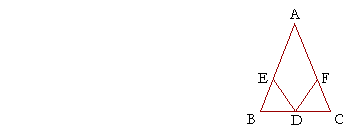Book I, Proposition 5Problems 1. a) State the hypothesis of Proposition 5. To see the answer, pass your mouse over the colored area. A triangle is isosceles. 1. b) State the conclusion. The angles at the base are equal. 2. ABC is a triangle with AB equal to AC; the base BC is bisected (cut 
3. into two equal parts) at D; and EB is equal to FC. Prove that ED is
Since, by hypothesis, EB is equal to FC, and BD equal to DC, 3. If two isosceles triangles are on opposite sides of the same base, then Table of Contents | Introduction | Home Please make a donation to keep TheMathPage online. Copyright © 2006-2007 Lawrence Spector Questions or comments? E-mail: themathpage@nyc.rr.com |